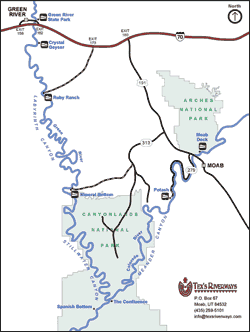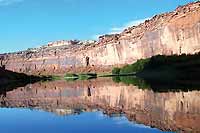Happy Cows Reside at Green River’s Ruby Ranch
|
The 2000-acre remote ranch is located 30 miles south of Green River, Utah. The property was owned by owner Kerry Rozman’s father before the flooding and declining health forced him into foreclosure. The San Rafael River meets its last flat spot on Rozman’s property before joining the Green River. Twice the property flooded during 1983 and 1984 ruining Rozman’s father’s property and equipment. For 13-years the property sat in foreclosure, before the FHA offered the family first opportunity to re-purchase the land at appraised value. 
At the time Rozman and her husband Curtis Rozman owned and operated a dairy farm in Riverton, Wyoming, which they sold when they were given the opportunity to purchase the family ranch again in 1998.
Immediately hit with the task of keeping the Flaming Gorge water rights on the property they either had to use the 600 acres of the water rights or lose it. They set up 850 acres of pivots or circular sprinklers that work well with the sandy soil.
With the help of their eight adopted children, they keep 150 Irish Black heifer cows at a time. They try to get a calf out of each mother each year. They rotate three bulls, one smaller bull for the heifer, along with two larger bulls to keep the genetics top quality, Rozman said. The castrated males, or steers, are sold as meat. They are castrated because the meat is more tender and marbled and they are easier to handle.
“To handle that many bulls would be crazy,” Rozman said.
Local restaurant Milts Stop and Eat purchases a steer a week, she said. They sell ½ and ¼ cows to individuals, Old Geezer, Moonflower Community Cooperative and some restaurants.
“The restaurants all want T-bones,” Rozman said, “exactly 12 oz. T-bones are hard!”
The restaurants are difficult to work with because there are only so many T-bones per cow, she said.
“Not every cow is the same size, just like us,” she said.
If they would request rib-eye there would be lots more supply, she said.
The ranch uses a sustainable farming plan and is one step away from being certified organic. The cows eat perennial grasses from the pasture and alfalfa hay.
“Everything they eat, we grow,” she said. 
In the winter they will feed them hay bales and hot rations. Hot rations or silage is made from the 50-60 acres of corn, chopping the entire stock, ear and cob, putting it into a pit and letting it ferment. It stays warm and moist, keeps through the winter and it is highly digestible.
During the winter the cows will eat 60-70 pounds a day; up to 25 pounds of grain, 25 pounds of silage and 25 pounds of alfalfa.
The cows are supplemented mineral salt and fed kelp. The kelp helps with fertility, immune resistance and provides electrolytes and helps with iodine deficiency. No hormones and no antibiotic shots are used!
What is next for Ruby Ranch? Local milk and cheese are certainly a possibility in the future.
If you want to see Ruby Ranch, people can launch boats at the ranch and enjoy a two-day float to Mineral Bottom, Utah, or check out sweeping views of the ranch while recreating around White Wash Sand Dunes! |

